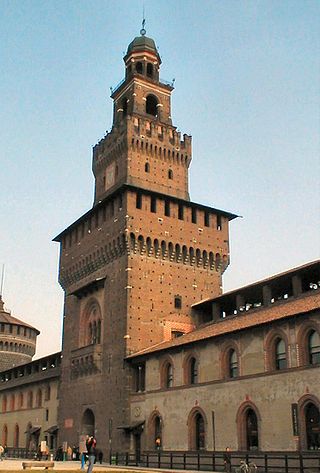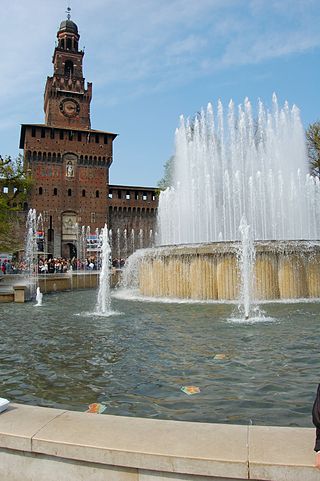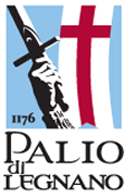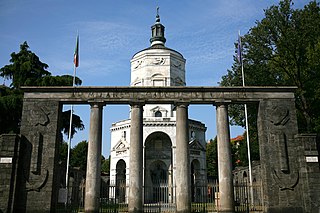
Milan is a city in northern Italy, regional capital of Lombardy, the largest city in Italy by urban population and the second-most-populous city proper in Italy after Rome. The city proper has a population of about 1.4 million, while its metropolitan city has 3.22 million residents. The urban area of Milan is the fourth-most-populous in the EU with 6.17 million inhabitants. According to national sources, the population within the wider Milan metropolitan area is estimated between 7.5 million and 8.2 million, making it by far the largest metropolitan area in Italy and one of the largest in the EU. Milan is the economic capital of Italy, one of the economic capitals of Europe and a global financial centre.

The Natural History Museum of the University of Pisa, located in the city of Pisa in Tuscany, Italy, is a renowned institution dedicated to the study and display of natural history. The museum is home to one of the largest collections of cetacean skeletons in Europe, showcasing an impressive array of marine mammal specimens. In addition to its extensive cetacean holdings, the museum's oldest collections include seashells amassed by the Italian invertebrate scientist, Niccolò Gualtieri. Serving as both an educational and research institution, the museum invites visitors and scholars to explore the diversity and complexity of the natural world.

Nausicaá Centre National de la Mer is a public aquarium located in Boulogne-sur-Mer in northern France. It is the largest public aquarium of Europe and attracts more than 800,000 visitors each year.
SECORE is an international non-profit organization focused on coral reef conservation. The group has over sixty supporters in North America, Europe and Japan, and comprises public aquariums, institutes, and universities. Founded in 2001 at the Rotterdam Zoo in the Netherlands, the organization has been developing methods of captive coral reproduction and preservation, citing studies that have predicted coral reefs could be extinct within decades due to climate change.

The Castellieri culture developed in Istria during the Early and Middle Bronze Age, and later expanded into Friuli, Dalmatia and the neighbouring areas. It lasted for more than a millennium, from the 18th century BC until the Roman conquest in the 3rd century BC. It takes its name from the fortified settlements, Castellieri, which characterized the culture. The term was coined by Carlo Marchesetti.

The Museo Egizio or Egyptian Museum is a museum sited in the Sforza Castle of Milan, Italy. The Castle is one of the most famous monuments in Milan and is home to several museums including the Egyptian Section of the Milan Archaeological Museum, the Museum of Ancient Art, the Pinacoteca and the Museum of Musical Instruments.

The Museum of Musical Instruments of Milan exhibits over 700 musical instruments from the fifteenth to twentieth centuries with particular attention to Lombard instruments. The collection contains plucked instruments, Lombard and Cremonese violins, hunting horns, numerous wood instruments, bassoons, pianos and some ancient organs. In particular the Cremonese lutherie is appreciated all over the world for the high quality of its musical instruments. The museum also displays the equipment of the former Studio di fonologia musicale di Radio Milano.

The Villa Belgiojoso Bonaparte, also known as Villa Reale and formerly called Villa Comunale, is a palace in Milan, in Lombardy in northern Italy. It was built between 1790 and 1796 as the residence of Count Ludovico Barbiano di Belgiojoso. The villa is in Neoclassical style, and was designed by Leopoldo Pollack. The main entrance is on via Palestro, facing the Giardini Pubblici of Porta Venezia, the eastern gate of the city.

The Diocesan Museum of Milan is an art museum in Milan housing a permanent collection of sacred artworks, especially from Milan and Lombardy. Originally conceived by Ildefonso Schuster in 1931 as a vehicle to protect and promote the art collection of the Archdiocese of Milan, the museum was eventually established in the former headquarters of the Dominican Order in the back of the Basilica of Sant'Eustorgio with the support of Pope Paul VI. In 2001 Carlo Maria Martini inaugurated the current venue located in Porta Ticinese.

Porta Nuova is one of the three medieval gates of Milan that still exist in the modern city. It is sited along the ancient "Navigli Ring" on the perimeter of the medieval walls of the city.

Casa Manzoni is a historical palace sited in via Morone 1 near the quadrilateral of fashion in the center of Milan, Italy. Owned by the Manzoni family, the house was the birthplace of the famous Italian writer Alessandro Manzoni in 1785.

The Applied Arts Collection of Milan is located in the Sforza Castle museum complex under the management of the municipality of Milan, Italy. The museum is divided into several sections with particular emphasis on jewelry, ivories, pottery and art glass.

The Antique Furnishings & Wooden Sculpture Museum of Milan is located on the first floor of the Sforza Castle ducal courtyard and it is part of the Sforza Castle's Civic Museum complex.

The Pusterla di Sant’Ambrogio is a minor or secondary gate in the Medieval walls of Milan; the rebuilt Romanesque-style tower and pedestrian arches is located on Via Carducci #41, near the Castello Cova and some 50 meters west of the entrance of the Basilica di Sant'Ambrogio in the center of Milan, region of Lombardy, Italy.

Piazza San Fedele is sited in Milan near Palazzo Marino, the Vittorio Emanuele II Gallery and Piazza della Scala in a pedestrian area in the centre of the city. The square is sited in front of at the homonymous San Fedele Church built based on an old project by Pellegrino Tibaldi in the 16th century and finally consecrated in the 18th century.

The Palio di Legnano is a traditional event generally held on the last Sunday of May in the city of Legnano, Italy, to recall the Battle of Legnano held on 29 May 1176 by the Lombard League and the Holy Roman Empire of Frederick Barbarossa. This Palio is composed by a medieval pageant and a horse race. Until 2005 the whole event was named Sagra del Carroccio.

Emanuele Corocher is an Italian writer born in Verona, Italy, living and working in Verona, Italy. His novel "Morire a Marcinelle" published by Tra le righe libri for the social theme and for the memory of the terrible disaster that took place in Marcinelle.

The Tempio della Vittoria or Temple of the Victory, also called the Shrine of the Fallen (Soldiers) of Milan is a monumental chapel building located on largo Agostino Gemelli, just north of the Basilica of Sant'Ambrogio and southwest of the Università Cattolica del Sacro Cuore in Milan, region of Lombardy, Italy.





























